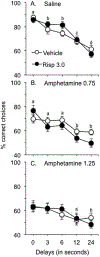The effects of amphetamine on working memory and locomotor activity in adult rats administered risperidone early in life
- PMID: 30594546
- PMCID: PMC6448153
- DOI: 10.1016/j.bbr.2018.12.044
The effects of amphetamine on working memory and locomotor activity in adult rats administered risperidone early in life
Abstract
Antipsychotic drugs are used to manage symptoms of pediatric psychiatric disorders despite the relative absence of research regarding the long-term effects of these drugs on brain development. Using rats as a model, research has demonstrated that administration of the antipsychotic drug, risperidone, during early postnatal development elevates locomotor activity and sensitivity to the locomotor effects of amphetamine during adulthood. Because risperidone targets neurotransmitter receptors and forebrain regions associated with working memory, the present study determined whether early-life risperidone altered working memory during adulthood and its sensitivity to amphetamine-induced impairment. Female and male rats received subcutaneous (sc) injections of risperidone daily on postnatal days 14-42. Early-life risperidone increased spontaneous locomotor activity and amphetamine-induced hyperactivity during adulthood, although the effects were significantly greater in females. Working memory was tested in an operant-based, delayed non-matching-to-sample task. Early-life risperidone did not affect the percentage of correct choices observed during sessions with 0-8 second delays but impaired performance during sessions with 0-24 second delays. In a subsequent set of tests using 0-24 second delays, amphetamine (0.75 and 1.25 mg/kg, sc) significantly reduced the percentage of correct choices at most delays, but risperidone did not exacerbate this effect. These data suggest that early-life risperidone leads to modest deficits in working memory during adulthood, but does not alter the perturbation of working memory by amphetamine.
Keywords: Antipsychotic; Catecholamine; Delayed non-matching-to-sample; Development; Dopamine; Forebrain; Frontal cortex; Learning.
Copyright © 2018 Elsevier B.V. All rights reserved.
Figures




Similar articles
-
Chronic risperidone administration leads to greater amphetamine-induced conditioned place preference.Neuropharmacology. 2020 Nov 15;179:108276. doi: 10.1016/j.neuropharm.2020.108276. Epub 2020 Aug 16. Neuropharmacology. 2020. PMID: 32814089 Free PMC article.
-
Early-life risperidone alters locomotor responses to apomorphine and quinpirole in adulthood.Behav Brain Res. 2024 Sep 13;473:115171. doi: 10.1016/j.bbr.2024.115171. Epub 2024 Jul 31. Behav Brain Res. 2024. PMID: 39094954
-
Early-life risperidone enhances locomotor responses to amphetamine during adulthood.Eur J Pharmacol. 2017 Oct 5;812:256-263. doi: 10.1016/j.ejphar.2017.07.025. Epub 2017 Jul 14. Eur J Pharmacol. 2017. PMID: 28716726 Free PMC article.
-
Delayed yet persistent effects of daily risperidone on activity in developing rats.Behav Pharmacol. 2016 Aug;27(5):460-9. doi: 10.1097/FBP.0000000000000230. Behav Pharmacol. 2016. PMID: 26960160 Free PMC article.
-
Adult rats treated with risperidone during development are hyperactive.Exp Clin Psychopharmacol. 2013 Jun;21(3):259-67. doi: 10.1037/a0031972. Exp Clin Psychopharmacol. 2013. PMID: 23750695 Free PMC article.
Cited by
-
Chronic risperidone administration leads to greater amphetamine-induced conditioned place preference.Neuropharmacology. 2020 Nov 15;179:108276. doi: 10.1016/j.neuropharm.2020.108276. Epub 2020 Aug 16. Neuropharmacology. 2020. PMID: 32814089 Free PMC article.
-
Amphetamine Modulation of Long-Term Object Recognition Memory in Rats: Influence of Stress.Front Pharmacol. 2021 Feb 24;12:644521. doi: 10.3389/fphar.2021.644521. eCollection 2021. Front Pharmacol. 2021. PMID: 33716754 Free PMC article.
-
Does Intravitreal Dopamine Agonist and Antagonist Administration Have Effects on the Brain? An Experimental Study in Rats.Eurasian J Med. 2022 Feb;54(1):54-60. doi: 10.5152/eurasianjmed.2022.21288. Eurasian J Med. 2022. PMID: 35307630 Free PMC article.
-
Early-life risperidone alters locomotor responses to apomorphine and quinpirole in adulthood.Behav Brain Res. 2024 Sep 13;473:115171. doi: 10.1016/j.bbr.2024.115171. Epub 2024 Jul 31. Behav Brain Res. 2024. PMID: 39094954
-
Long-term effects of adolescent exposure to olanzapine in C57BL/6 J mice and the impact of dietary fish oil supplementation.Psychopharmacology (Berl). 2022 Oct;239(10):3117-3131. doi: 10.1007/s00213-022-06193-7. Epub 2022 Jul 27. Psychopharmacology (Berl). 2022. PMID: 35896725
References
Publication types
MeSH terms
Substances
Grants and funding
LinkOut - more resources
Full Text Sources

